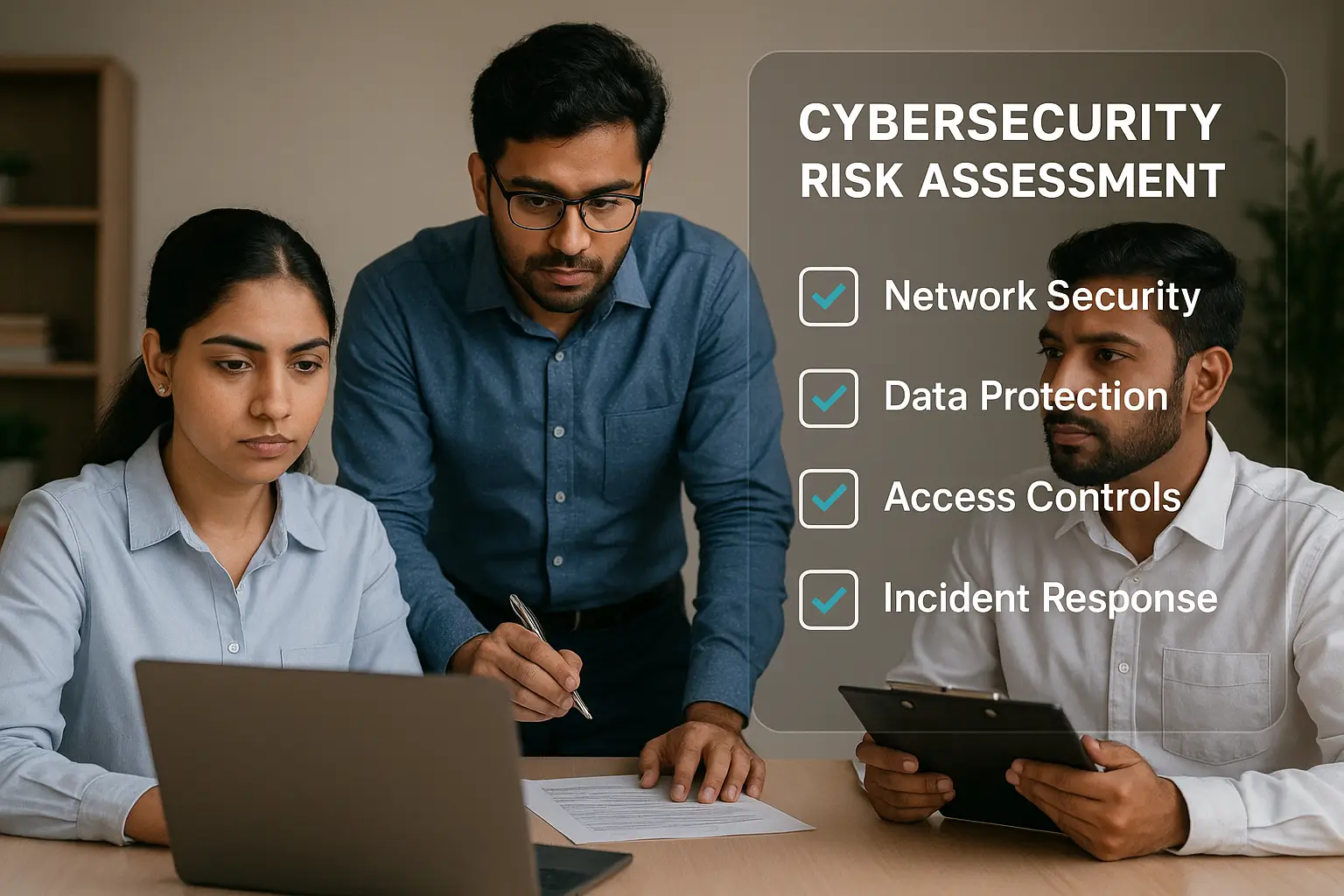Cybersecurity risk assessment India is no longer optional for small and medium-sized businesses. With increasing digital adoption, Indian SMEs face growing cyber threats—from phishing attacks to data breaches and ransomware. A single cyber incident can lead to severe financial loss, compliance issues, and reputation damage. This is where a strong cybersecurity risk assessment India strategy becomes essential for SMEs to protect their digital growth.
Yet, many SMEs in India don’t know where to begin when it comes to evaluating cyber risks. This blog breaks it down into five simple, actionable steps that any SME can follow to secure their data, systems, and customer trust.
What Is a Cybersecurity Risk Assessment?
A cybersecurity risk assessment is the process of identifying, analyzing, and evaluating cyber threats that can impact your business systems, data, and operations. It helps you prioritize security investments, comply with regulations, and prepare for future incidents.
In the Indian context, risk assessments are essential for:
- 📊 Aligning with CERT-In guidelines
- ✅ Meeting data protection standards (DPDP Act, 2023)
- 🔐 Preparing for client audits (especially for export-oriented IT firms)
- 💼 Reducing cost of cyber insurance premiums
Implementing a robust cybersecurity risk assessment India framework enables businesses to proactively address risks before damage occurs.
Why Cybersecurity Risk Assessment Matters for Indian SMEs
According to a report by DSCI and PwC, over 76% of Indian SMEs experienced cyber attacks in the past year, yet less than 30% had a formal risk assessment strategy. As SMEs increasingly store data in CRMs, cloud apps, and ERPs, they become high-value targets with low defenses.
Government regulations are also tightening. With the enforcement of the Digital Personal Data Protection Act and rising client demand for secure IT ecosystems, even small service providers must demonstrate cyber readiness.
How to Conduct a Cybersecurity Risk Assessment – Step by Step
Let’s dive into the five essential steps to conduct an effective cybersecurity risk assessment in India for SMEs.
Step 1: Identify All Digital Assets
Start by making an inventory of everything that connects to your business digitally:
- Workstations, laptops, servers
- Wi-Fi networks and routers
- Cloud tools (Google Workspace, Microsoft 365, CRMs)
- Databases and APIs
- Customer portals or websites
Understanding your digital ecosystem is the first step in a proper cybersecurity risk assessment India plan.
Step 2: Identify Potential Cyber Threats
Classify threats that are most relevant to your industry. For example:
- Phishing emails targeting finance staff
- Ransomware attacking network drives
- Unauthorized access to customer data
- Weak passwords on cloud logins
Use threat libraries like MITRE ATT&CK or Indian CERT-In advisories for reference.
Step 3: Evaluate Vulnerabilities
Conduct basic security audits using tools like:
Common vulnerabilities in Indian SMEs include:
- Outdated antivirus software
- Unpatched Windows systems
- Use of cracked or pirated software
- Single admin access without MFA
Step 4: Analyze Risk Impact and Likelihood
Once you’ve identified threats and vulnerabilities, rate them based on:
- Likelihood: How likely is the threat to occur?
- Impact: What is the financial or reputational loss?
Use a simple matrix (Low, Medium, High) to visualize risks. This helps SMEs prioritize where to invest — such as strong firewalls for data servers or endpoint protection for employee devices.
Step 5: Build a Mitigation and Monitoring Plan
Once risks are ranked, develop an action plan. For example:
- Use MFA (multi-factor authentication) across all admin accounts
- Train staff with simulated phishing attacks
- Set up automated daily backups
- Use centralized antivirus and patch management
Monitor systems regularly using tools like OSSEC, Wazuh, or third-party MSSPs.
🛠️ Cybersecurity Risk Assessment Tools for Indian SMEs
Many tools now exist to support a cost-effective cybersecurity risk assessment India process tailored for SMEs.
| Tool | Use | Free/Paid |
|---|---|---|
| OpenVAS | Vulnerability scanning | Free |
| CyberHygiene Toolkit (CERT-In) | Guidelines for small enterprises | Free |
| Wazuh | Security monitoring & log analysis | Free/Premium |
| Zoho Vault | Password manager for teams | Freemium |
| Microsoft Security Center | SMB protection suite | Free with Microsoft 365 |
⚠️ Common Mistakes SMEs Make During Cybersecurity Risk Assessment
Even with the best intentions, Indian SMEs often overlook critical aspects during a cybersecurity risk assessment India strategy. These mistakes can leave gaps that cybercriminals exploit:
- Incomplete Asset Listing: Failing to include mobile devices, USB drives, or remote worker systems.
- No Employee Involvement: Ignoring non-IT staff who often face phishing or social engineering threats.
- Generic Risk Scoring: Using imported templates without localizing to India-specific threats and compliance needs.
- Skipping Regular Reviews: Risk assessments are not one-time tasks—they should be updated every 6–12 months.
- Neglecting Third-Party Risks: Vendors, cloud partners, or outsourced developers may be your weakest link.
Understanding these common issues ensures that your cybersecurity risk assessment India efforts lead to real security improvements—not just documents for audits.
✅ Internal Links
🔗 External Links
❓ FAQs – Cybersecurity Risk Assessment India
How often should Indian SMEs conduct a cybersecurity risk assessment?
At least once every 6–12 months or after any major system changes. High-risk industries should assess quarterly.
Is a cybersecurity risk assessment mandatory in India?
While not legally mandatory for all SMEs, it is essential under DPDP and NIS2 guidelines, especially for those handling personal or export data.
Can SMEs do risk assessments without hiring a consultant?
Yes, using tools like OpenVAS and CERT-In toolkits. However, a certified consultant is recommended for audits tied to regulatory or client compliance.
What’s the average cost of a cybersecurity risk assessment in India?
For SMEs, initial assessments can start from ₹15,000–₹50,000 depending on complexity and coverage. Government incentives or MSME grants may help offset costs.
What’s the first step toward cybersecurity compliance in India?
A full cybersecurity risk assessment India roadmap is the recommended first step, especially for SMEs working with client or cloud data.
Need help with your first cybersecurity risk assessment? Right Web Solution provides custom cybersecurity risk assessment India services designed for startups and growing businesses. At Right Web Solution, we specialize in helping Indian SMEs secure their digital infrastructure with practical, cost-effective solutions.
📞 Call: +91 8850 907518
📩 Email: hello@rightwebsolution.com
🌐 Website: https://rightwebsolution.com









